仁爱版英语七年级上册
- 格式:pdf
- 大小:238.37 KB
- 文档页数:3
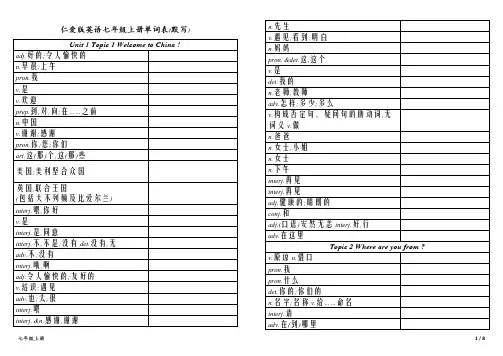
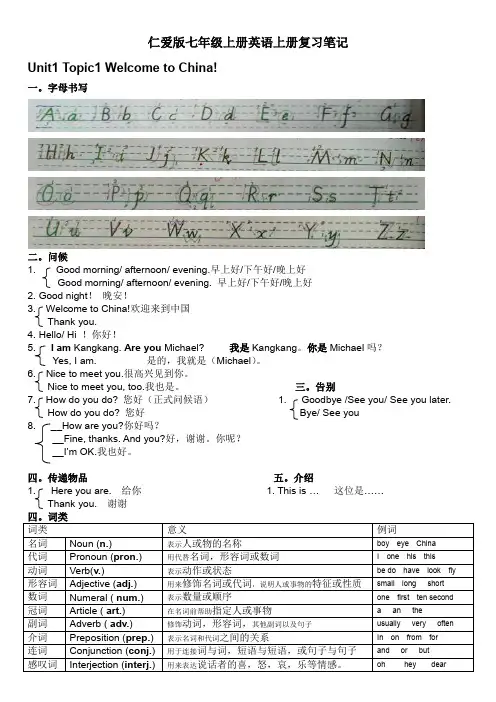
仁爱版七年级上册英语上册复习笔记Unit1 Topic1 Welcome to China!一。
字母书写二。
问候1. Good morning/ afternoon/ evening.早上好/下午好/晚上好Good morning/ afternoon/ evening. 早上好/下午好/晚上好2. Good night!晚安!3. Welcome to China!欢迎来到中国Thank you.4. Hello/ Hi !你好!5. I am Kangkang. Are you Michael? 我是Kangkang。
你是Michael吗?Yes, I am. 是的,我就是(Michael)。
6. Nice to meet you.很高兴见到你。
Nice to meet you, too.我也是。
三。
告别7. How do you do? 您好(正式问候语) 1. Goodbye /See you/ See you later.How do you do? 您好Bye/ See you8. __How are you?你好吗?__Fine, thanks. And you?好,谢谢。
你呢?__I’m OK.我也好。
四。
传递物品五。
介绍1. Here you are. 给你 1. This is …这位是……Thank you.谢谢四。
词类词类意义例词名词Noun (n.) 表示人或物的名称boy eye China代词Pronoun (pron.) 用代替名词,形容词或数词I one his this动词Verb(v.) 表示动作或状态be do have look fly 形容词Adjective (adj.) 用来修饰名词或代词,说明人或事物的特征或性质small long short数词Numeral ( num.) 表示数量或顺序one first ten second 冠词Article ( art.) 在名词前帮助指定人或事物 a an the副词Adverb ( adv.) 修饰动词,形容词,其他副词以及句子usually very often 介词Preposition (prep.) 表示名词和代词之间的关系In on from for连词Conjunction (conj.) 用于连接词与词,短语与短语,或句子与句子and or but感叹词Interjection (interj.) 用来表达说话者的喜,怒,哀,乐等情感。

仁爱版英语七年级词汇总表(上下册)仁爱版英语七年级上册1第1单元1话题1 欢迎来到中国.好的,良好的n.早晨;上午.欢迎;.欢迎 .受欢迎的.到,对,向;给;在……之前 (动词不定式符号,无词义)n.中国v.谢谢,感谢,致谢;n.(只用复数)谢谢,感谢,谢意.你;你们.喂;你好(表示打招呼、问候或唤起注意)I .我v.是I' ( )我是v.是.是,好,同意;(用于表示疑问、征询等,常用升调)什么;是吗 .不;不是;.没有,无,不.不;没.哦;啊.令人愉快的;好的,漂亮的 v.相识,结识;遇见,见到.也,还;又;太,过分;很,非常.喂;你好(表示打招呼、问候或唤起注意)n.(用于对女教师的称呼);女士;小姐(对未婚女性的称呼).这;这个v.是. ()n.(用于对男教师的称呼);先生(用于男子姓氏或姓名前)v.看见,看到;明白,领会;拜会.我的(形容词性物主代词)n.妈妈n.老师,教师,教员.怎样,如何;多少;多么.构成否定句、疑问句的助动词,无词义;v.做;干;行动n.下午;午后.(身体)健康的;美好的;晴朗的 .再见,再会.再见n.傍晚,晚上.和;又;而.(口语)好,对,不错.以后;后来;.晚些的,迟些的 1第1单元2 ?话题2 你来自哪里?v.原谅;宽恕.我(宾格)劳驾,请原谅(尤其是引起陌生人的注意).什么,怎么样.你的;你们的(形容词性物主代词)n.名字,姓名,名称 .在哪里;往哪里.来自;从;从……起来自n.加拿大.这(那)个;这(那)些U.S.A.()美国;美利坚合众国.她.他' ()n.日本.我们n.英格兰.谁他/她/它们;人们' ()n.古巴.零.一;.(用来代替单数的人或物)一(个,只……).二.三.四.五.六.七.八.九.十n.电话(机);v.打电话n.号码;数,数字;数量 .它1第1单元3 ?话题3 你在哪个班?.十一.十二.十三.十四.十五.十六.十七.十八.十九.二十n.年.……岁的;老的;旧的(s) ……岁...? ……多少岁?n.(学校里的)班级;课;同一个班的学生.在……里(内;上);用……;.穿着,戴着;.在家,在内,向内n.年级.那;那个n.英语;.英国的;英国人的;英语的用英语(表达).一(个,件……)n.( )橡皮擦;黑板擦a .一(个;件……)n.地图v.拼写v.可能;能够;可以.请;v.使人高兴,使人满意n.铅笔n.苹果.双的;两倍的;n.两个;双n.玩具;玩物.呀;哇(表示赞叹或惊奇)n.书桌,写字台n.钢笔,笔n.尺子;直尺n.书;本子n.小汽车,轿车n.橘子,橙子;橘汁;橘色;.橙色的,橘色的n.蛋;卵n.黑板.这些.那些n.书包n.蛋糕;糕点,饼n.公共汽车n.盒子,箱子.现在n.学校'北京仁爱国际学校.她的(形容词性物主代词);.她(宾格)n.电话;v.打电话.他的(形容词性物主代词);.他的(名词性物主代词).同样的;同一的;n.同样的事 .但是,可是n.朋友身份证号码.初级的;年少的.高的;高度的初中(美国等国家12至14岁的孩子上的学校)2第2单元1 I a .话题1 我有一个小鼻子。

2024年仁爱版英语教材七年级上册In the first half of the school year, students will focus on developing their listening, speaking, reading, and writing skills. They will learn to introduce themselves and others, talk about their daily routines, describe their families and friends, express likes and dislikes, and discuss hobbies and interests.In Unit 1, students will learn basic greetings and introductions. They will practice asking and answering questions about names, ages, and nationalities. Unit 2 will cover talking about daily routines, including time expressions and activity vocabulary.Unit 3 will focus on family and friends, teaching students how to describe family members and relationships. Unit 4 will introduce students to expressing likes and dislikes, with vocabulary related to hobbies and activities.In the second half of the year, students will continue to build on these foundational skills while also learning about different cultures and traditions. They will study topics such as food and eating habits, school life, and holidays and celebrations.Overall, the seventh-grade English curriculum will provide a strong foundation for students to communicate effectively in both spoken and written English, while also fostering an appreciation for diverse cultures and perspectives.。
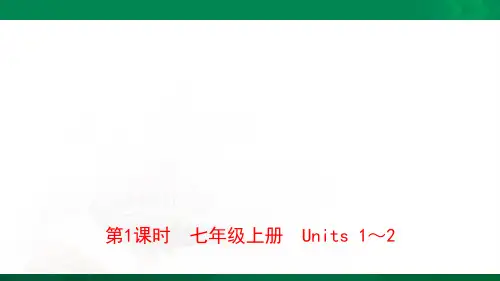
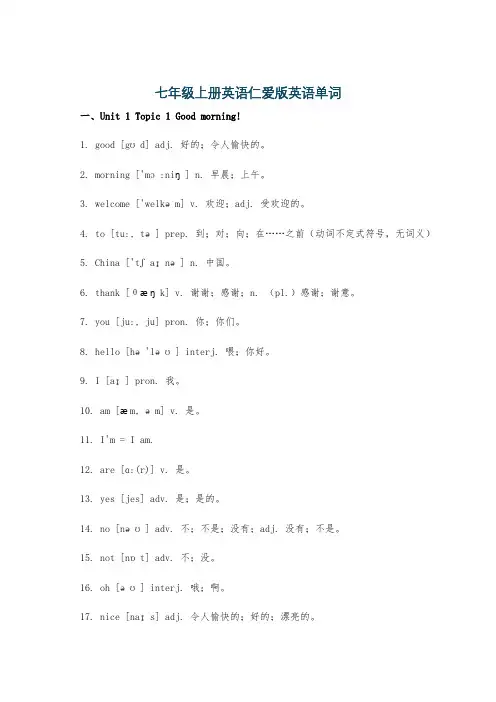
七年级上册英语仁爱版英语单词一、Unit 1 Topic 1 Good morning!1. good [gʊd] adj. 好的;令人愉快的。
2. morning ['mɔ:niŋ] n. 早晨;上午。
3. welcome ['welkəm] v. 欢迎;adj. 受欢迎的。
4. to [tu:, tə] prep. 到;对;向;在……之前(动词不定式符号,无词义)5. China ['tʃaɪnə] n. 中国。
6. thank [θæŋk] v. 谢谢;感谢;n. (pl.)感谢;谢意。
7. you [ju:, ju] pron. 你;你们。
8. hello [hə'ləʊ] interj. 喂;你好。
9. I [aɪ] pron. 我。
10. am [æm, əm] v. 是。
11. I'm = I am.12. are [ɑ:(r)] v. 是。
13. yes [jes] adv. 是;是的。
14. no [nəʊ] adv. 不;不是;没有;adj. 没有;不是。
15. not [nɒt] adv. 不;没。
16. oh [əʊ] interj. 哦;啊。
17. nice [naɪs] adj. 令人愉快的;好的;漂亮的。
18. meet [mi:t] v. 遇见;见到;n. 会;集会。
19. too [tu:] adv. 也;还;太;过分。
20. hi [haɪ] interj. 嗨;喂(唤起注意,表示惊讶或询问)二、Unit 1 Topic 2 Where are you from?1. from [frəm] prep. 从;从……起;距;来自。
2. Canada ['kænədə] n. 加拿大。
3. England ['ɪŋglənd] n. 英国。
4. the [ðə, ði:] art. 这(那)个;这(那)些(用于特定人或物,序数词,最高级,专有名词,世上独一无二的事物前)5. United States [ju'naɪtɪ d steɪts] n. 美国(美利坚合众国)6. they [ðeɪ] pron. 他(她、它)们。
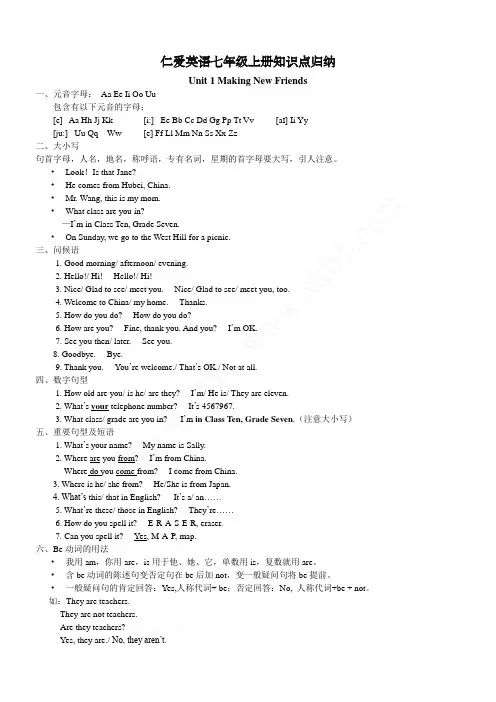
仁爱英语七年级上册知识点归纳Unit 1 Making New Friends一、元音字母:Aa Ee Ii Oo Uu包含有以下元音的字母:[e] Aa Hh Jj Kk [i:] Ee Bb Cc Dd Gg Pp Tt Vv [aɪ] Ii Yy[ju:] Uu Qq Ww [e] Ff Ll Mm Nn Ss Xx Zz二、大小写句首字母,人名,地名,称呼语,专有名词,星期的首字母要大写,引人注意。
•Look!Is that Jane?•He comes from Hubei, China.•Mr. Wang, this is my mom.•What class are you in?—I’m in Class Ten, Grade Seven.•On Sunday, we go to the West Hill for a picnic.三、问候语1. Good morning/ afternoon/ evening.2. Hello!/ Hi! ---Hello!/ Hi!3. Nice/ Glad to see/ meet you. ---Nice/ Glad to see/ meet you, too.4. Welcome to China/ my home. ---Thanks.5. How do you do? ---How do you do?6. How are you? ---Fine, thank you. And you? ---I’m OK.7. See you then/ later. ---See you.8. Goodbye. ---Bye.2. What.(注意大小写)1. What5. What’re these/ those in English? ---They’re……6. How do you spell it? ---E-R-A-S-E-R, eraser.7. Can you spell it? ---Yes, M-A-P, map.六、Be动词的用法•我用am,你用are,is用于他、她、它,单数用is,复数就用are。

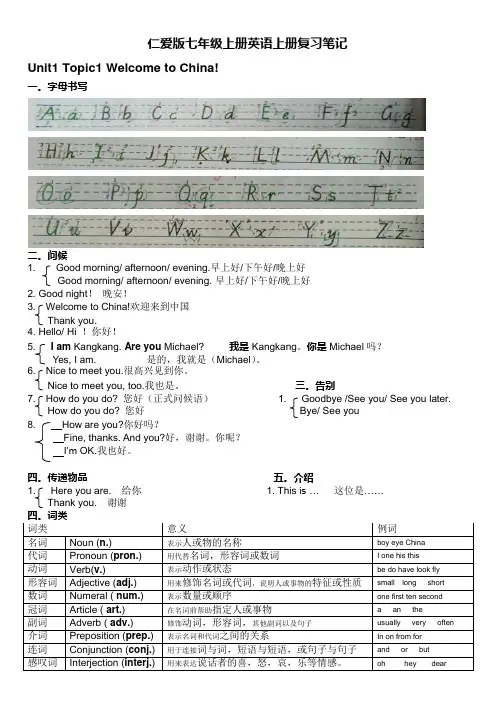
仁爱版七年级上册英语上册复习笔记Unit1 Topic1 Welcome to China!一。
字母书写二。
问候1. Good morning/ afternoon/ evening.早上好/下午好/晚上好Good morning/ afternoon/ evening. 早上好/下午好/晚上好2. Good night!晚安!3. Welcome to China!欢迎来到中国Thank you.4. Hello/ Hi !你好!5. I am Kangkang. Are you Michael? 我是Kangkang。
你是Michael 吗?Y e s, I am. 是的,我就是(M ichael)。
6. Nice to meet you.很高兴见到你。
Nice to meet you, too.我也是。
三。
告别7. How do you do? 您好(正式问候语) 1. Goodbye /See you/ See you later.How do you do? 您好Bye/ See you8. How are you?你好吗?Fine, thanks. And you?好,谢谢。
你呢?I’m OK.我也好。
四。
传递物品五。
介绍1. Here you are. 给你 1. This is …这位是……Thank you. 谢谢四。
词类词类意义例词名词Noun (n.) 表示人或物的名称boy eye China代词Pronoun (pron.) 用代替名词,形容词或数词I one his this动词Verb(v.) 表示动作或状态be do have look fly形容词Adjective (adj.) 用来修饰名词或代词,说明人或事物的特征或性质small long short 数词Numeral ( num.) 表示数量或顺序one first ten second冠词Article ( art.) 在名词前帮助指定人或事物 a an the副词Adverb ( adv.) 修饰动词,形容词,其他副词以及句子usually very often 介词Preposition (prep.) 表示名词和代词之间的关系In on from for连词Conjunction (conj.) 用于连接词与词,短语与短语,或句子与句子and or but感叹词Interjection (interj.) 用来表达说话者的喜,怒,哀,乐等情感。

Unit 1 Making New Friends Topic 1 Welcome to China! Section AThe main activities are 1a, 2a and 3a. 本课重点活动是1a, 2a和3a。
Ⅰ. 教学目标1.(1)Learn the letters Aa-Gg.(2)Learn some new words:good, morning, welcome, to, China, thank, you, hello, I, am, are, yes, no, not, nice, meet, too2. Learn about greetings and introductions:(1)—Good morning.—Good morning.(2)—Welcome to China!—Thank you./Thanks.(3)—Hello/Hi!—Hello/Hi!(4)—I’m … Are you …?—Yes, I am./No, I’m not. I’m …(5)—Nice to meet you.—Nice to meet you, too.Ⅱ. 教具录音机/字母卡片Ⅲ. 五指教学方案第一步介绍(时间:6分钟)本节课是开篇,教师应向全体学生说明以下两点:1.学习英语的重要性。
2.学习英语的正确方法。
目的:激发学生学习英语的兴趣,提高学习效率。
第二步呈现(时间:9分钟)呈现简单的打招呼用语,并进行听说练习,学以致用。
1. (运用真实情境,让学生学会如何与他人简单地打招呼。
)(1)(教师向一学生做手势以示打招呼。
)S1:Hello!(启发学生回答。
)让学生猜测其意思并掌握。
)Hello!)T: Hello!Ss:Hello!)1(同时教师可以请一位学生帮忙,示范熟人之间应怎样打招呼。
并让学生之间用真实姓名依次操练)T: Please look at us and see how we are greeting. Then you can use your names to greet each other.(教师给以适当的汉语提示。
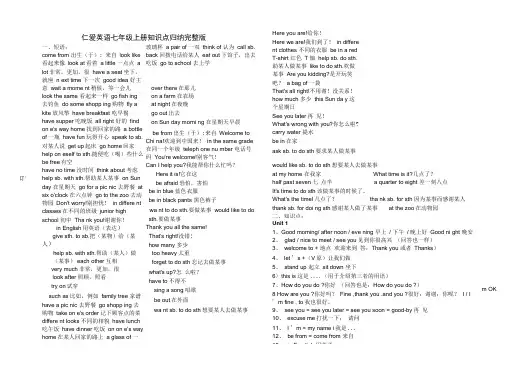
一、短语:come from 出生(于); 来自look like 看起来像look at看着 a little 一点点 a lot非常,更加,很have a seat坐下,就座n ext time 下一次good idea 好主意wait a mome nt稍候,等一会儿look the same 看起来一样go fish ing去钓鱼do some shopp ing 购物fly a kite放风筝have breakfast 吃早餐have supper 吃晚饭all right 好的find on e's way home找到回家的路a bottle of 一瓶have fun玩得开心speak to sb.对某人说get up起床go home回家help on eself to sth.随便吃(喝)些什么be free有空have no time 没时间think about 考虑help sb. with sth.帮助某人某事on Sun day 在星期天go for a pic nic 去野餐at six o'clock 在六点钟go to the zoo 去动物园Don't worry!别担忧!in differe nt classes在不同的班级junior high school 初中Tha nk you!谢谢你!in English用英语(表达)give sth. to sb.把(某物)给(某人)help sb. with sth.帮助(某人)做(某事) each other 互相very much非常,更加,很look after照顾,照看try on试穿such as比如,例如family tree 家谱have a pic nic 去野餐go shopp ing 去购物take on e's order记下顾客点的菜differe nt looks不同的相貌have lunch 吃午饭have dinner 吃饭on on e's way home在某人回家的路上a glass of 一玻璃杯 a pair of 一双think of 认为call sb. back回拨电话给某人eat out下馆子,出去吃饭go to school 去上学over there在那儿on a farm在农场at night在夜晚go out出去on Sun day morni ng 在星期天早晨be from出生(于);来自Welcome to Chi na!欢迎到中国来!in the same grade 在同一个年级teleph one nu mber 电话号码You're welcome!别客气!Can I help you?我能帮你什么忙吗?Here it is!它在这be afraid恐怕,害怕be in blue蓝色衣服be in black pants 黑色裤子wa nt to do sth.要做某事would like to do sth.要做某事Thank you all the same!That's right!没错!how many 多少too heavy 太重forget to do sth忘记去做某事what's up?怎么啦?have to不得不sing a song 唱歌be out在外面wa nt sb. to do sth想要某人去做某事仁爱英语七年级上册知识点归纳完整版订' Here you are!给你!Here we are!我们到了!in different clothes 不同的衣服be in a redT-shirt 红色T 恤help sb. do sth.助某人做某事like to do sth.欢做某事Are you kidding?是开玩笑吧? a bag of 一袋That's all right!不用谢!没关系!how much 多少this Sun da y这个星期日See you later再见!What's wrong with you?你怎么啦?carry water 提水be in在家ask sb. to do sth要求某人做某事would like sb. to do sth想要某人去做某事at my home 在我家What time is it?几点了?half past seven七点半 a quarter to eight 差一刻八点It's time to do sth该做某事的时候了。
仁爱英语七年级上册知识点归纳完整版一、短语:comefrom出生(于);来自inEnglish用英语(表达)looklike看起来像.把(某物)给(某人) lookat看着.帮助(某人)做(某事)alittle一点点eachother互相alot非常,更加,很verymuch非常,更加,很haveaseat坐下,就座lookafter照顾,照看nexttime下一次tryon试穿goodidea好主意suchas比如,例如waitamoment稍候,等一会儿familytree 家谱lookthesame看起来一样haveapicnic去野餐gofishing去钓鱼goshopping去购物dosomeshopping购物takeone'sorder记下顾客点的菜flyakite放风筝differentlooks不同的相貌havebreakfast吃早餐havelunch吃午饭havesupper吃晚饭havedinner吃饭allright好的onone'swayhome在某人回家的路上findone'swayhome找到回家的路aglassof 一玻璃杯abottleof一瓶apairof一双havefun玩得开心thinkof认为speaktosb.对某人说回拨电话给某人getup起床eatout下馆子,出去吃饭gohome回家gotoschool去上学helponeselftosth.随便吃(喝)些什么befree有空havenotime没时间overthere在那儿thinkabout考虑onafarm在农场.帮助某人某事atnight在夜晚onSunday在星期天goout出去goforapicnic去野餐onSundaymorning在星期天早晨atsixo'clock在六点钟befrom出生(于);来自gotothezoo去动物园WelcometoChina!欢迎到中国来!Don'tworry!别担忧!inthesamegrade在同一个年级indifferentclasses在不同的班级telephonenumber电话号码juniorhighschool初中You'rewelcome!别客气!Thankyou!谢谢你!CanIhelpyou?我能帮你什么忙吗?Hereyouare!给你!Hereitis!它在这Hereweare!我们到了!beafraid恐怕,害怕indifferentclothes不同的衣服beinblue 蓝色衣服beinaredT-shirt红色T恤beinblackpants 黑色裤子.助某人做某事wanttodosth.要做某事liketodosth.欢做某事wouldliketodosth.要做某事?Areyoukidding?是开玩笑吧?Thankyouallthesame!是要谢谢你!abagof一袋That'sright!没错!That'sallright!不用谢!没关系!howmany 多少howmuch多少tooheavy太重thisSunday这个星期日forgettodosth.忘记去做某事Seeyoulater!再见!what'sup?怎么啦?What'swrongwithyou?你怎么啦?haveto 不得不carrywater提水singasong唱歌bein在家beout在外面.要求某人做某事.想要某人去做某事.想要某人去做某事atmyhome在我家Whattimeisit?几点了?halfpastseven七点半aquartertoeight差一刻八点It'stimetodosth.该做某事的时候了。
仁爱版英语七年级上册知识点总结一、重点词汇解析1.good /ɡʊd/:好的。
-例句:She is a good student.(她是一个好学生。
)-用法:可用于形容人、事物等。
常见短语有be good at(擅长),be good for (对……有好处)。
2.morning /ˈmɔːnɪŋ/:早晨;上午。
-例句:Good morning!(早上好!)-用法:in the morning(在上午)。
3.hello /həˈləʊ/:你好;喂。
-例句:Hello! Nice to see you.(你好!很高兴见到你。
)-用法:用于打招呼。
/neɪm/:名字。
-例句:What's your name?(你叫什么名字?)-用法:常见短语有full name(全名),first name(名字),last name(姓)。
5.welcome /ˈwelkəm/:欢迎。
-例句:Welcome to our school.(欢迎来到我们学校。
)-用法:welcome to + 地点,表示“欢迎来到……”。
6.this /ðɪs/:这;这个。
-例句:This is a book.(这是一本书。
)-用法:用于指近处的人或物。
7.that /ðæt/:那;那个。
-例句:That is a pen.(那是一支钢笔。
)-用法:用于指远处的人或物。
8.teacher /ˈtiːtʃə(r)/:教师。
-例句:She is a teacher.(她是一名教师。
)-用法:常见短语有English teacher(英语老师),math teacher(数学老师)等。
9.thank /θæŋk/:谢谢;感谢。
-例句:Thank you.(谢谢你。
)-用法:thanks = thank you,常见短语有thank sb. for sth.(因某事感谢某人)。
10.you /juː/:你;你们。
仁爱版初中英语七年级上册(英语单词表,带发音)Unit 1 - Topic 1good英音 [ɡʊd]美音 [ɡʊd]n. 好处;善行;慷慨的行为 adj. 好的;优良的;愉快的;虔诚的 adv. 好morning英音 [ˈmɔːnɪŋ]美音 [ˈmɔːrnɪŋ]n. 早晨;黎明;初期I英音 [a ɪ]美音 [aɪ]n. 碘元素;英语字母I pron. 我am英音 [əm; æm]美音 [əm; æm]abbr. 调幅 v. 是welcome英音 [ˈwelk əm]美音 [ˈwelk əm]n. 欢迎 vt. 欢迎 adj. 受欢迎的 int. 欢迎to英音 [t ə]美音 [tə; tu; tuː]prep. 到;向;(表示时间、方向)朝…方向adv. 向前;(门等)关上China英音 [ˈtʃaɪnə]美音 [ˈtʃaɪnə]n. 中国 n. china,瓷器 adj. 中国的;中国制造的 adj. china,瓷制的thank 英音 [θæŋk]美音 [θæŋk]n. 感谢 vt. 感谢 int. 谢谢you英音 [ju]美音 [juː; jə]pron. 你;你们the英音 [ðə]美音 [ðə; ði; ðiː]art. 这;那 adv. 更加(用于比较级,最高级前)the USA美国;美利坚合众国;现在我们有美国的大哥the UK(等于the United Kingdom)英国hello英音 [həˈləʊ]美音 [həˈl əʊ]n. 表示问候, 惊奇或唤起注意时的用语 int.喂;哈罗are 英音 [ɑ:(r)]美音 [ər; ɑːr; er]v. 是(be的第二人称单复数现在式) n. 公亩yes 英音 [jes]美音 [jes]n. 是(表示肯定) adv. 是, 是的no英音 [nəʊ]美音 [noʊ]adv. 不 adj. 没有;不是 n. 不;否决票 abbr.数字(number);元素锘(nobelium)的…not英音 [nɒt]美音 [nɑːt]adv. 表示否定,不 n. “非”(计算机中逻辑运算的一种)oh英音 [əʊ]美音 [oʊ]int. 哦;哎呀(表示惊讶或恐惧等)adj. 精密的;美好的;细微的;和蔼的nice英音 [naɪs]美音 [naɪs]meet英音 [miːt]美音 [miːt]vt. 满足;遇见;对付 vi. 相遇;接触 n. 集会adj. 合适的;适宜的too英音 [tuː]美音 [tuː]adv. 太;也;很;还;非常;过度hi英音 [haɪ]美音 [haɪ]int. 嗨!(表示问候或用以唤起注意)thanks 英音 [θæŋks]n. 谢谢(只用复数) int. 谢谢美音 [θæŋks]n. 先生Mr.英音 [ˈmɪstə(r)]美音 [ˈmɪstər]see英音 [siː]美音 [siː]vi. 看;看见;领会 vt. 看见;理解;领会n. 妈妈mom英音 [mɒm]美音 [mɑːm]this英音 [ðɪs]美音 [ðɪs]adj. 这;本;这个;今 pron. 这;这个;这里adv. 这样地;这么is英音 [ɪz]美音 [ɪz]v. 是(be的三单形式) n. 存在my英音 [maɪ]美音 [maɪ]pron. 我的 int. 哎呀(表示惊奇等);喔唷n. 教师;导师teacher英音 [ˈtiːtʃə(r)]美音 [ˈtiːtʃər]how英音 [haʊ]美音 [haʊ]adv. 如何;多少;多么 n. 方法;方式 conj.如何do英音 [duː; də; du; dəʊ]vi. 行,足够;生长 n. 要求;规定;C大调音Unit 1 - Topic 2美音 [du ː; d ə; du; do ʊ]阶中的第音v 做;干;学习;研究;进行dad英音 [dæd]美音 [dæd]n. 爸爸;爹爹Miss英音 [m ɪs]美音 [m ɪs]n. 女士,小姐,年轻未婚女子 vt. 错过,想念,缺(勤)Ms.英音 [m ɪz; m əz]美音 [m ɪz; m əz]女士afternoon 英音 [ˌɑːft əˈnu ːn]美音 [ˌæft ər ˈnu ːn]n. 午后,下午goodbye 英音 [ˌɡʊd ˈba ɪ]美音 [ˌɡʊd ˈba ɪ]int. 再见 放弃 告别bye 英音 [ba ɪ]美音 [ba ɪ]n. 轮空;次要的东西 int. 再见 adj. 次要的fine英音 [fa ɪn]美音 [fa ɪn]n. 罚款 adj. 好的;优良的;细小的,精美的;健康的;晴朗的 vt. 罚款;澄清 adv. 很…and 英音 [ənd]美音 [ənd; ən; n; ænd]conj. 和,与;就;而且;但是;然后OK 英音 [əʊˈke ɪ]美音 [ˌo ʊ'ke ɪ]adj. 好的;不错的 adv. 行;很好 int. 好;可以 vt. 对…表示同意 n. 同意here 英音 [h ɪə(r)]美音 [h ɪr]n. 这里 adv. 在这里;此时 int. 嘿!;喂!excuse英音 [ɪk ˈskju ːs]美音 [ɪk ˈskju ːs]n. 借口;理由 vt. 原谅;为…申辩;给…免去vi. 作为借口;请求宽恕;表示宽恕me英音 [mi; mi ː]美音 [mi; mi ː]pron. 我(宾格) n. 自我;极端自私的人;自我的一部分what英音 [w ɒt]美音 [w ʌt]pron. 什么;多么;多少 adv. 到什么程度,在哪一方面 adj. 什么;多么;何等 int. 什么;…your英音 [j ɔː(r); j ə(r)]pron. 你的,你们的name英音 [neɪm]美音 [neɪm]n. 名称,名字;姓名;名誉 vt. 命名,任命;指定;称呼;提名;叫出 adj. 姓名的;据以…please英音 [pliːz]美音 [pliːz]int. 请(礼貌用语) vt. 使喜欢;使高兴,使满意 vi. 讨人喜欢;令人高兴where英音 [weə(r)]美音 [wer]conj. 在…的地方 n. 地点 adv. 在哪里 pron.哪里from英音 [frəm; frɒm]美音 [frəm; frʌm; frɑːm]prep. 来自,从;由于;今后Canada英音 [ˈkænədə]美音 [ˈkænədə]n. 加拿大(北美洲国家)America英音 [əˈmerɪkə]美音 [əˈmerɪkə]n. 美洲(包括北美和南美洲);美国Japan英音 [dʒəˈpæn]美音 [dʒəˈpæn]n. 日本(东亚国家名)England英音 [ˈɪŋɡlənd]美音 [ˈɪŋɡlənd]n. 英格兰they英音 [ðeɪ]美音 [ðeɪ]pron. 他们;它们;她们who英音 [huː]美音 [huː]pron. 谁;什么人Cuba英音 [ˈkjuːbə]美音 [ˈkjuːbə]n. 古巴(拉丁美洲国家)he英音 [hi; iː; i; hiː]美音 [hi; iː; i; hiː]n. 男孩,男人;它(雄性动物) pron. 他she英音 [ʃi]美音 [ʃi; ʃiː]n. 女人;雌性动物 pron. 她(主格);它(用来指雌性动物或国家、船舶、地球、月亮等)look英音 [lʊk]美音 [lʊk]vt. 看;期待;注意;面向;看上去像 vi. 看;看起来;注意;面向 n. 看;样子;面容telephone英音 [ˈtelɪfəʊn]n. (美)电话;电话机;电话耳机 vt. 打电话给… vi. 打电话number英音 [ˈnʌmbə(r)]美音 [ˈnʌmbər]n. 数;(杂志等的)期;号码;数字;算术vi. 计入;总数达到 vt. 编号;计入;数…的…it英音 [ɪt]美音 [ɪt]abbr. 信息技术information technologyabbr. 意大利Italy;意大利的Italianvery英音 [ˈveri]美音 [ˈveri]adv. 非常,很;完全 adj. 恰好是,正是;甚至;十足的;特有的much英音 [mʌtʃ]美音 [mʌtʃ]adv. 非常,很 adj. 大量的 n. 许多,大量pron. 许多,大量very much英音 [ˈveri mʌtʃ]美音 [ˈveri mʌtʃ]adv. 非常that 英音 [ðæt]美音 [ðæt]conj. 因为;以至于 adj. 那;那个 pron. 那;那个 adv. 那么;那样zero英音 [ˈzɪərəʊ]美音 [ˈzɪroʊ]num. 零 n. 零点,零度one英音 [wʌn]美音 [wʌn]pron. 一个人;任何人 adj. 一的;唯一的 n.一 num. 一;一个two英音 [tuː]美音 [tuː]num. 二 n. 两个 adj. 两个的three英音 [θriː]美音 [θriː]num. 三 n. 三,三个 adj. 三的,三个的four英音 [fɔː(r)]美音 [fɔːr]num. 四;四个 adj. 四的;四个的five英音 [faɪv]美音 [faɪv]num. 五,五个 n. 五,五个;五美元钞票 adj.五的;五个的six英音 [sɪks]美音 [sɪks]num. 六,六个 n. 六,六个seven英音 [ˈsev(ə)n]美音 [ˈsev(ə)n]num. 七个,七 n. 七个,七 adj. 七的;七个的eight英音 [eɪt]美音 [eɪt]num. 八;八个;第八 n. 八字形 adj. 八的nine英音 [naɪn]美音 [naɪn]n. 九,九个 num. 九;九个 adj. 九的,九个的Unit 1 - Topic 3ten 英音 [ten]美音 [ten]num. 十个,十her英音 [h ə(r)]美音 [h ər; ɜːr; ər; h ɜːr]pron. 她(she的宾格);她的(she的所有格);她(指某个国家;一艘船)family英音 [ˈfæm əli]美音 [ˈfæm əli]n. 家庭;亲属;家族;子女;[生]科;语族;[化]族 adj. 家庭的;家族的;适合于全家的twelve英音 [twelv]美音 [twelv]num. 十二;十二个 n. 十二;十二个 adj. 十二的;十二个的year英音 [j ɪə(r)]美音 [j ɪr]n. 年;年度;历年;年纪;一年的期间;某年级的学生old英音 [əʊld]美音 [o ʊld]adj. 陈旧的,古老的;年老的 n. 古时class英音 [klɑːs]美音 [klæs]n. 阶级;班级;种类;班;等级 adj. 极好的;很好的,优秀的,出色的 vt. 分类;把……in英音 [ɪn]美音 [ɪn]prep. 按照(表示方式);从事于;在…之内n. 执政者;门路;知情者 adj. 在里面的;时…grade英音 [ɡre ɪd]美音 [ɡre ɪd]n. 年级;等级;成绩;级别;阶段 vt. 评分;把…分等级 vi. 分等级;逐渐变化eleven英音 [ɪˈlev(ə)n]美音 [ɪˈlevn]num. 十一;十一个 n. 十一;十一个 adj. 十一的;十一个的thirteen英音 [ˌθɜːˈti ːn]美音 [ˌθɜːr ˈti ːn]n. 十三;十三岁;十三个 num. 十三 adj. 十三的;十三个的fourteen英音 [ˌf ɔːˈti ːn]美音 [ˌf ɔːr ˈti ːn]num. 十四;十四个;第十四 n. 十四的记号;十四岁;十四点钟;十五世纪fifteen英音 [ˌf ɪf ˈti ːn]美音 [ˌf ɪf ˈti ːn]n. 十五;十五个;十五人组成的橄榄球队num. 十五 adj. 十五的sixteen英音 [ˌs ɪks ˈti ːn]美音 [ˌs ɪks ˈti ːn]num. 十六 adj. 十六的,十六个的seventeen英音 [ˌsev(ə)nˈtiːn]美音 [ˌsevnˈtiːn]n. 十七,十七个 num. 十七 adj. 十七岁的;十七的,十七个的eighteen英音 [ˌeɪˈtiːn]美音 [ˌeɪˈtiːn]n. 十八,十八个 num. 十八 adj. 十八个的,十八的nineteen英音 [ˌnaɪnˈtiːn]美音 [ˌnaɪnˈtiːn]num. 十九twenty英音 [ˈtwenti]美音 [ˈtwenti]num. 二十 n. 二十;二十年代 adj. 二十的English英音 [ˈɪŋɡlɪʃ]美音 [ˈɪŋɡlɪʃ]n. 英语;英国人;英文;英格兰人 adj. 英国人的;英国的;英文的 vt. 把…译成英语an英音 [ən]美音 [ən; æn]art. 一(在元音音素前)eraser英音 [ɪˈreɪzə(r)]美音 [ɪˈreɪsər]n. 橡皮;擦除器;[计] 清除器map 英音 [mæp]美音 [mæp]vt. 映射;计划;绘制地图;确定基因在染色体中的位置 n. 地图;示意图;染色体图 vi. 基…pen 英音 [pen]美音 [pen]n. 钢笔;作家;围栏 vt. 写;关入栏中pencil英音 [ˈpens(ə)l]美音 [ˈpensl]n. 铅笔;笔状物 vt. 用铅笔写;用眉笔涂 vi.成铅笔状desk 英音 [desk]美音 [desk]n. 办公桌;服务台;编辑部;(美)讲道台;乐谱架 adj. 书桌的;桌上用的;伏案做的spell 英音 [spel]美音 [spel]n. 符咒;一段时间;魅力 vi. 拼字;轮替 vt.拼,拼写;意味着;招致;拼成;迷住;轮值a英音 [ə]美音 [ə; eɪ]n. 字母A;第一流的;学业成绩达最高标准的评价符号 abbr. [物]安(ampere)can英音 [kən; kæn]美音 [kən; kæn]aux. 能; 能够; 可以; 可能 n. 罐头; (用金属或塑料制作的)容器; (马口铁或其他…apple英音 [ˈæp(ə)l]n. 苹果,苹果树,苹果似的东西;[美俚]炸弹,手榴弹,(棒球的)球;[美俚]人,家…美音 [ˈæpl]toy英音 [tɔɪ]美音 [tɔɪ]n. 玩具;小装饰品;不值钱的东西 adj. 作为玩具的;玩物似的 vi. 玩弄;调情;随随便便…wow英音 [waʊ]美音 [waʊ]n. 极大的成功;一鸣惊人之举;魔兽世界(World of Warcraft);失真 int. (表示极大…try英音 [traɪ]美音 [traɪ]n. 尝试;努力;试验 vt. 试图,努力;试验;审判;考验 vi. 尝试;努力;试验again英音 [əˈɡen]美音 [əˈɡen; əˈɡeɪn]adv. 又,此外;再一次;再说;增加 n.(英、保)阿盖恩those英音 [ðəʊz]美音 [ðoʊz]adj. 那些的 pron. 那些(that的复数)book英音 [bʊk]美音 [bʊk]n. 书籍;卷;帐簿;名册;工作簿 vt. 预订;登记these英音 [ðiːz]美音 [ðiːz]adj. 这些的 pron. 这些let 英音 [let]美音 [let]vt. 允许,让;出租;假设;妨碍 vi. 出租;被承包 n. 障碍;出租屋help 英音 [help]美音 [help]n. 帮助;补救办法;帮忙者;有益的东西 vt.帮助;促进;治疗;补救 vi. 帮助;有用;招…ruler英音 [ˈruːlə(r)]美音 [ˈruːlər]n. 尺;统治者;[测] 划线板,划线的人car英音 [kɑː(r)]美音 [kɑːr]n. 汽车;车厢egg 英音 [eɡ]美音 [eɡ]n. 蛋;卵子;家伙;鸡蛋 vt. 煽动;怂恿orange英音 [ˈɒrɪndʒ]美音 [ˈɔrɪndʒ]adj. 橙色的;橘色的 n. 橙;橙色;桔子bus英音 [bʌs]美音 [bʌs]n. 公共汽车 乘公共汽车box英音 [bɒks]美音 [bɑːks]n. 箱,盒子;包厢;一拳 vt. 拳击;装…入盒中;打耳光 vi. 拳击adv. 现在;如今;立刻 adj. 现在的 n. 现在;Review of Unit 1now 英音 [na ʊ]美音 [na ʊ]现在;如今;立刻j 现在的现在;目前 conj. 由于;既然school英音 [sku ːl]美音 [sku ːl]n. 学校;学院;学派;鱼群 vt. 教育Beijing International School 无his英音 [h ɪz]美音 [h ɪz; ɪz]pron. 他的same英音 [se ɪm]美音 [se ɪm]adj. 相同的;同一的;上述的(通常与the连用);无变化的 adv. 同样地(通常与the连…but英音 [b ət]美音 [b ət; b ʌt]conj. 但是;而是;然而 adv. 仅仅,只 prep.除…以外friend英音 [frend]美音 [frend]n. 朋友;助手;赞助者junior英音 [ˈd ʒu ːni ə(r)]美音 [ˈd ʒu ːni ər]adj. 年少的;后进的;下级的 n. 年少者,晚辈;地位较低者;大学三年级学生high英音 [ha ɪ]美音 [ha ɪ]n. 高水平;天空;由麻醉品引起的快感;高压地带 adj. 高的;高级的;崇高的;高音调的…junior high schooln. (美国)初级中学girl英音 [ɡɜːl]美音 [ɡɜːrl]n. 女孩;姑娘,未婚女子;女职员,女演员;(男人的)女朋友 n. (捷)吉尔we英音 [wi; wi ː]美音 [wi]pron. 我们(主格);笔者,本人(作者或演讲人使用);朕,寡人student英音 [ˈstju ːdnt]美音 [ˈstu ːdnt]n. 学生;学者speak英音 [spi ːk]vi. 说话;演讲;表明;陈述 vt. 讲话;发言;讲演Unit 2 - Topic 1美音 [spiːk]guess 英音 [ɡes]美音 [ɡes]n. 猜测;推测 vi. 猜;推测;猜中 vt. 猜测;认为;推测;猜中 n. 盖尔斯(美国服装品…have英音 [həv]美音 [həv; əv; hæv]aux. 已经 vt. 有;让;拿;从事;允许small英音 [smɔːl]美音 [smɔːl]n. 小件物品;矮小的人 adj. 少的,小的;微弱的;几乎没有的;不重要的;幼小的 adv.…nose英音 [nəʊz]美音 [noʊz]n. 鼻子;嗅觉;突出的部分;探问 vt. 嗅;用鼻子触 vi. 小心探索着前进;探问has英音 [həz]美音 [həz; əz; hæz]v. 有,吃,得到,从事,允许,雇用,享有(have的第三人称单数);(亲属关系中)…big英音 [bɪɡ]美音 [bɪɡ]adj. 大的;重要的;量大的 adv. 大量地;顺利;夸大地eye英音 [aɪ]美音 [aɪ]n. 眼睛;视力;眼光;见解,观点 vt. 注视,看know英音 [nəʊ]美音 [noʊ]vt. 知道;认识;懂得 vi. 了解;熟悉;确信right英音 [raɪt]美音 [raɪt]n. 正确;右边;正义 adj. 正确的;直接的;右方的 vt. 纠正 adv. 正确地;恰当地;彻底…ear英音 [ɪə(r)]美音 [ɪr]n. 耳朵;穗;听觉;倾听 vi. (美俚)听见;抽穗hair英音 [heə(r)]美音 [her]n. 头发;毛发;些微 adj. 毛发的;护理毛发的;用毛发制成的 vt. 除去…的毛发 vi. 生长…head 英音 [hed]美音 [hed]n. 头;头痛;上端;最前的部分;理解力 adj.头的;主要的;在顶端的 vt. 前进;用头顶…face英音 [feɪs]美音 [feɪs]n. 脸;表面;面子;面容;外观;威信 vi.向;朝 vt. 面对;面向;承认;抹盖neck 英音 [nek]美音 [nek]n. 脖子;衣领;海峡 vi. 搂著脖子亲吻;变狭窄 vt. 使变细;与…搂著脖子亲吻mouth英音 [maʊθ]美音 [maʊθ]n. 口,嘴;河口 vt. 做作地说,装腔作势地说;喃喃地说出 vi. 装腔作势说话round英音 [raʊnd]美音 [raʊnd]n. 圆;循环;一回合;圆形物 prep. 附近;绕过;大约;在…周围 adj. 圆的;完全的;大…long英音 [lɒŋ]美音 [lɔːŋ]n. 长时间;[语] 长音节;(服装的)长尺寸;长裤 adj. 长的;过长的;做多头的;长时间…wide英音 [waɪd]美音 [waɪd]n. 大千世界 adj. 广泛的;宽的,广阔的;张大的;远离目标的 adv. 广泛地;广阔地;充…favorite英音 [ˈfeɪvərɪt]美音 [ˈfeɪvərɪt]n. 幸运儿;喜欢的事物;特别喜欢的人 adj.最喜爱的;中意的;宠爱的actor英音 [ˈæktə(r)]美音 [ˈæktər]n. 男演员;行动者;作用物Chinese英音 [ˌtʃaɪˈniːz]美音 [ˌtʃaɪˈniːz]n. 中文,汉语;中国人 adj. 中国的,中国人的;中国话的does英音 [dʌz]美音 [dʌz]v. 做;工作;有用(do的第三人称单数形式)arm英音 [ɑːm]美音 [ɑːrm]n. 手臂;武器;袖子;装备;部门 vt. 武装;备战 vi. 武装起来hand 英音 [hænd]美音 [hænd]n. 手,手艺;帮助;指针;插手 vt. 传递,交给;支持;搀扶leg 英音 [leɡ]美音 [leɡ]n. 腿;支柱foot英音 [fʊt]美音 [fʊt]n. 脚;英尺;步调;末尾 vt. 支付;给……换底 vi. 步行;跳舞;总计short英音 [ʃɔːt]美音 [ʃɔːrt]n. 短;缺乏;短路;短裤 adj. 短的;不足的;矮的,低的 adv. 不足;突然;唐突地boy英音 [bɔɪ]美音 [bɔɪ]n. 男孩;男人come英音 [kʌm]美音 [kʌm]vi. 来;开始;出现;发生;变成;到达 vt.做;假装;将满(…岁) int. 嗨!come from v. 来自;出身;归因于Unit 2 - Topic 2sister 英音 [ˈs ɪst ə(r)]美音 [ˈs ɪst ər]n. 姐妹;(称志同道合者)姐妹;修女;护士adj 姐妹般的;同类型的different 英音 [ˈd ɪfr ənt]美音 [ˈd ɪfr ənt]adj. 不同的;个别的,与众不同的knife 英音 [na ɪf]美音 [na ɪf]n. 刀;匕首 vt. 用刀切;(口)伤害 vi. 劈开;划过black英音 [blæk]美音 [blæk]n. 黑色;黑人;黑颜料 adj. 黑色的;黑人的;邪恶的 vt. 使变黑;把鞋油等涂在…上;…blond英音 [bl ɒnd]美音 [blɑːnd]adj. 金发的 n. 白肤碧眼金发的人blue英音 [blu ː]美音 [blu ː]adj. 蓝色的;沮丧的,忧郁的;下流的 n. 蓝色;[复数](美国海、陆、空三军穿的)蓝色…color英音 [ˈk ʌl ə(r)]美音 [ˈk ʌl ər]n. 颜色;肤色;颜料;脸色 vt. 粉饰;给...涂颜色;歪曲 vi. 变色;获得颜色pink英音 [p ɪŋk]美音 [p ɪŋk]n. 粉红色;化身,典范;石竹花;头面人物adj. 粉红的;比较激进的;石竹科的;脸色…red英音 [red]美音 [red]n. 红色,红颜料;赤字 adj. 红色的;红肿的,充血的purple英音 [ˈp ɜːp(ə)l]美音 [ˈp ɜːrpl]n. 紫色;紫袍 adj. 紫色的;帝王的;华而不实的 vt. 使成紫色 vi. 变成紫色brown英音 [bra ʊn]美音 [bra ʊn]n. 褐色,棕色 adj. 棕色的,褐色的;太阳晒黑的 vt. 使变成褐色 vi. 变成褐色gray英音 [ɡre ɪ]美音 [ɡre ɪ]n. 灰色;暗淡的光线 adj. 灰色的;苍白的;灰白头发的;阴郁的 vt. 使成灰色或灰白 vi. …yellow英音 [ˈjel əʊ]美音 [ˈjelo ʊ]n. 黄色;黄种人;黄色颜料 adj. 黄色的;黄皮肤的 vt. 使变黄或发黄 vi. 变黄或发黄green英音 [ɡri ːn]n. 绿色;青春 adj. 绿色的;青春的 vt. 使…变美音 [ɡriːn]绿色i变绿色white英音 [waɪt]美音 [waɪt]n. 白色;洁白;白种人 adj. 白色的;白种的;纯洁的give英音 [ɡɪv]美音 [ɡɪv]n. 弹性;弯曲;伸展性 vi. 捐赠;面向;有弹性;气候转暖 vt. 给;产生;让步;举办;…letter英音 [ˈletə(r)]美音 [ˈletər]n. 信;字母,文字;证书;文学,学问;字面意义 vt. 写字母于 vi. 写印刷体字母sorry英音 [ˈsɒri]美音 [ˈsɑːri]adj. 遗憾的;对不起的,抱歉的 int. 对不起,抱歉(表示委婉的拒绝等)like英音 [laɪk]美音 [laɪk]vt. 喜欢;想;愿意 vi. 喜欢;希望 prep. 像;如同 adj. 同样的;相似的 n. 爱好;同样的…tall英音 [tɔːl]美音 [tɔːl]adj. 高的;长的;过分的;夸大的 adv. 夸大地will英音 [wɪl]美音 [wɪl]n. 意志;决心;情感;遗嘱;意图;心愿 vt.决心要;遗赠;用意志力使 vi. 愿意;下决心…for英音 [fə(r)]美音 [fər; fɔːr]prep. 为,为了;因为;给;对于;至于;适合于 conj. 因为young英音 [jʌŋ]美音 [jʌŋ]n. 年轻人;(动物的)崽,仔 adj. 年轻的;初期的;没有经验的man 英音 [mæn]美音 [mæn]n. 人;男人;人类;丈夫;雇工 vt. 操纵;给…配置人员;使增强勇气;在…就位woman英音 [ˈwʊmən]美音 [ˈwʊmən]n. 妇女;女性;成年女子snowman英音 [ˈsnəʊmæn]美音 [ˈsnoʊmæn]n. 雪人want英音 [wɒnt]美音 [wɑːnt]n. 需要;缺乏;贫困;必需品 vt. 需要;希望;应该;缺少 vi. 需要;缺少buy英音 [baɪ]美音 [baɪ]n. 购买,买卖;所购的物品 vi. 买,采购 vt.购买;获得;贿赂T-shirt英音 [ˈtiːʃɜːt]美音 [ˈtiːʃɜːrt]n. 短袖圆领汗衫cap 英音 [kæp]美音 [kæp]n. 盖;帽子 vt. 覆盖;胜过;给…戴帽;加盖于 vi. 脱帽致意pair英音 [peə(r)]美音 [per]n. 一对,一双,一副 vt. 把…组成一对of英音 [əv; ɒv]美音 [əv; ʌv]prep. 关于;属于;…的;由…组成的shoe英音 [ʃuː]美音 [ʃuː]n. 鞋;蹄铁;外胎 vt. 给……穿上鞋;穿……鞋coat英音 [kəʊt]美音 [koʊt]n. 外套 vt. 覆盖…的表面dress 英音 [dres]美音 [dres]n. 连衣裙;女装 vt. 给…穿衣 vi. 穿衣pants 英音 [pænts]美音 [pænts]n. 裤子skirt英音 [skɜːt]美音 [skɜːrt]n. 裙子 vt. 绕过,回避;位于…边缘 vi. 沿边走,绕开;环绕glove英音 [ɡlʌv]美音 [ɡlʌv]n. 手套 vt. 给…戴手套at英音 [ət]美音 [ət; æt]prep. 在(表示存在或出现的地点、场所、位置、空间);以(某种价格、速度等);向…look at na. 看;考虑photo英音 [ˈfəʊtəʊ]美音 [ˈfoʊtoʊ]n. 照片strong英音 [strɒŋ]美音 [strɔːŋ]adj. 坚强的;强壮的;牢固的;擅长的 adv.强劲地;猛烈地happy英音 [ˈhæpi]美音 [ˈhæpi]adj. 幸福的;高兴的;巧妙的Unit 2 - Topic 3next 英音 [nekst]美音 [nekst]adv. 然后;下次;其次 adj. 下一个的;其次的贴近的下个靠近居于之后next to prep. 紧邻;在…近旁;仅次于;紧接shirt 英音 [ʃɜːt]美音 [ʃɜːrt]n. 衬衫;汗衫,内衣cool英音 [ku ːl]美音 [ku ːl]n. 凉爽;凉爽的空气 adj. 凉爽的;冷静的;出色的 vt. 使…冷却;使…平静下来 vi. 变凉…other 英音 [ˈʌðə(r)]美音 [ˈʌðər]adj. 其他的,另外的 pron. 另外一个mine英音 [ma ɪn]美音 [ma ɪn]n. 矿,矿藏;矿山,矿井;地雷,水雷 vt. 开采,采掘;在…布雷 vi. 开矿,采矿;埋设地…whose英音 [hu ːz]美音 [hu ːz]pron. 谁的(疑问代词)then英音 [ðen]美音 [ðen]conj. 然后,当时 n. 那时 adv. 然后;那么;于是;当时;此外yours英音 [j ɔːz]美音 [j ərz; j ɔːrz; j ʊrz]pron. 你(们)的东西;你的责任[义务];你的家属;来信,尊函 adj. 你(们)的(东西)…hers英音 [h ɜːz]美音 [h ɜːrz; ɜːrz]pron. 她的(所有格)ours英音 [ˈa ʊəz]美音 [ˈa ʊərz]pron. 我们的theirs英音 [ðe əz]美音 [ðerz]pron. 他们的;她们的;它们的bike英音 [ba ɪk]美音 [ba ɪk]n. 自行车;脚踏车 vi. 骑自行车(或摩托车)cat 英音 [kæt]美音 [kæt]n. 猫,猫科动物our英音 [ɑː(r)]美音 [ɑːr]pron. 我们的Unit 3 - Topic 1banana 英音 [b əˈnɑːn ə]美音 [b əˈnæn ə]n. 香蕉;喜剧演员;大鹰钩鼻their 英音 [ðe ə(r)]美音 [ðer]pron. 他们的,她们的;它们的jacket 英音 [ˈd ʒæk ɪt]美音 [ˈd ʒæk ɪt]n. 羽绒滑雪衫;西装短外套;短上衣,夹克;土豆皮;书籍的护封;文件套,公文夹 vt.…think 英音 [θɪŋk]美音 [θɪŋk]n. 想;想法 adj. 思想的 vi. 想;认为 vt. 想;认为;想起;想像;打算schoolbag 英音 [ˈsku ːlbæɡ]美音 [ˈsku ːl ˌbæɡ]n. 书包baby 英音 [ˈbe ɪbi]美音 [ˈbe ɪbi]n. 婴儿,婴孩;孩子气的人 adj. 婴儿的;幼小的 vt. 纵容,娇纵;把……当婴儿般对待new 英音 [nju ː]美音 [nu ː]adj. 新的,新鲜的;更新的;初见的 adv. 新近classmate 英音 [ˈklɑːsme ɪt]美音 [ˈklæsme ɪt]n. 同班同学clothes 英音 [kl əʊðz]美音 [klo ʊðz; klo ʊz]n. 衣服us 英音 [əs; ʌs]美音 [əs; ʌs]pron. 我们find 英音 [fa ɪnd]美音 [fa ɪnd]n. 发现 vi. 裁决 vt. 查找,找到;发现;认为;感到;获得him 英音 [h ɪm; ɪm]美音 [h ɪm; ɪm]pron. 他(宾格)police 英音 [p əˈli ːs]美音 [p əˈli ːs]n. 警察,警方;治安 adj. 警察的;有关警察的 vt. 监督;管辖;维持治安;为…配备警察could英音 [k əd]aux. 能够 v. 能(can的过去式)美音 [kəd; kʊd]tell 英音 [tel]美音 [tel]vt. 告诉,说;辨别;吩咐;断定 vi. 讲述;告发,泄密;识别sure英音 [ʃʊə(r)]美音 [ʃʊr]adj. 确信的;可靠的;必定的 adv. 当然;的确pen pal英音 [ˈpen pæl]美音 [ˈpen pæl]abbr. (=pen-friend) n. 笔友some英音 [sʌm]美音 [sʌm; səm]adj. 一些;某个;大约;相当多的 pron. 一些;若干;其中的一部分;(数量不确切时…with英音 [wɪð]美音 [wɪð; wɪθ]prep. 用;随着;支持;和…在一起problem英音 [ˈprɒbləm]美音 [ˈprɑːbləm]n. 难题;引起麻烦的人 adj. 成问题的;难处理的well 英音 [wel]美音 [wel]n. 井;源泉 adj. 良好的;健康的;适宜的adv. 很好地;充分地;满意地;适当地 v. 涌…often英音 [ˈɒf(ə)n]美音 [ˈɔːf(ə)n]adv. 常常,时常lot英音 [lɒt]美音 [lɑːt]n. 份额;许多;命运;阄 adv. (与形容词和副词连用)很,非常;(与动词连用)非常…a lot n. 许多 adv. 常about英音 [əˈbaʊt]美音 [əˈbaʊt]prep. 关于;大约 n. 大致;粗枝大叶;不拘小节的人 adj. 在附近的;四处走动的;在起作…live英音 [lɪv; laɪv]美音 [lɪv; laɪv]adj. 活的;生动的;实况转播的;精力充沛的vt. 经历;度过 vi. 活;居住;生存say英音 [seɪ]美音 [seɪ]vt. 讲;说明;例如;声称;假设;指明 vi.讲;表示;念;假定;背诵visit英音 [ˈvɪzɪt]美音 [ˈvɪzɪt]n. 访问;参观;逗留 vt. 访问;参观;视察 vi.访问;暂住;闲谈many英音 [ˈmeni]pron. 许多;许多人 adj. 许多的Unit 3 - Topic 2美音 [ˈmeni]little英音 [ˈl ɪt(ə)l]美音 [ˈl ɪtl]adj. 小的;很少的;短暂的;小巧可爱的 adv.完全不 n. 少许;没有多少;短时间a little n. 一点so英音 [s əʊ]美音 [so ʊ]conj. 所以;因此 adv. 如此,这么;确是如此pron. 这样them英音 [ðəm; ðem]美音 [ðəm; ðem]pron. 他们;它们;她们each英音 [i ːt ʃ]美音 [i ːt ʃ]adj. 每;各自的 pron. 每个;各自 adv. 每个;各自each other pron. 彼此all英音 [ɔːl]美音 [ɔːl]n. 全部 adj. 全部的 adv. 全然地;越发 pron.全部not ... at all na. 毫无(=〔美国英语〕 You are welcome)read英音 [ri ːd]美音 [ri ːd]n. 阅读;读物 adj. 有学问的 vi. 读;读起来vt. 阅读;读懂,理解a lot of det. 许多people英音 [ˈpi ːp(ə)l]美音 [ˈpi ːpl]n. 人;人类;民族;公民 vt. 居住于;使住满人every英音 [ˈevri]美音 [ˈevri]adj. 每一的,每个的;每隔…的day英音 [de ɪ]美音 [de ɪ]n. 一天;时期;白昼 adj. 日间的;逐日的adv. 每天;经常在白天地home英音 [h əʊm]美音 [ho ʊm]n. 家,住宅;产地;家乡;避难所 adj. 国内的,家庭的;有效的 vt. 归巢,回家 adv. 在 (i)英音 [k ɪd]美音 [k ɪd]n. 小孩;小山羊 vt. 欺骗;取笑;戏弄 vi. 欺骗;取笑;戏弄 adj. 小山羊皮制的;较年幼的glad 英音 [ɡlæd]美音 [ɡlæd]adj. 高兴的;乐意的;令人高兴的;灿烂美丽的vt使高兴mother英音 [ˈmʌðə(r)]美音 [ˈmʌðər]n. 母亲;大娘;女修道院院长 vt. 生下;养育;像母亲般关怀或照管 adj. 母亲的;出生…father英音 [ˈfɑːðə(r)]美音 [ˈfɑːðər]n. 父亲,爸爸;神父;祖先;前辈 vt. 发明,创立;当…的父亲doctor英音 [ˈdɒktə(r)]美音 [ˈdɑːktər]vt. 修理;篡改,伪造;为…治病;授以博士学位 n. 医生;博士 vi. 就医;行医parent英音 [ˈpeərənt]美音 [ˈperənt]n. 父亲(或母亲);父母亲;根源office英音 [ˈɒfɪs]美音 [ˈɑːfɪs]n. 办公室;政府机关;官职;营业处worker英音 [ˈwɜːkə(r)]美音 [ˈwɜːrkər]n. 工人;劳动者;职蚁driver英音 [ˈdraɪvə(r)]美音 [ˈdraɪvər]n. 驾驶员;驱动程序;起子;传动器farmer英音 [ˈfɑːmə(r)]美音 [ˈfɑːrmər]n. 农夫,农民cook英音 [kʊk]美音 [kʊk]n. 厨师,厨子 vt. 烹调,煮 vi. 烹调,做菜nurse英音 [nɜːs]美音 [nɜːrs]vt. 看护,护理;照顾;培养;给…喂奶 vi. 照料,护理;喂奶;当保姆 n. 护士;奶妈,保…show英音 [ʃəʊ]美音 [ʃoʊ]n. 显示;表演;炫耀 vt. 显示;说明;演出;展出 vi. 显示;说明;指示work英音 [wɜːk]美音 [wɜːrk]n. 工作;[物] 功;产品;操作;职业;行为;事业;工厂;著作;文学、音乐或艺术作品 …hospital英音 [ˈhɒspɪt(ə)l]美音 [ˈhɑːspɪtl]n. 医院restaurant英音 [ˈrestrɒnt]n. 餐馆;[经] 饭店美音 [ˈrestrɑːnt; ˈrestərɑːnt]on英音 [ɒn]美音 [ɑːn]adv. 向前地;作用中,行动中;继续着 prep.向,朝……;关于;在……之上;在……时候…farm英音 [fɑːm]美音 [fɑːrm]n. 农场;农家;畜牧场 vt. 养殖;耕种;佃出(土地) vi. 种田,务农;经营农场teach英音 [tiːtʃ]美音 [tiːtʃ]vt. 教;教授;教导 vi. 教授;讲授;当老师act 英音 [ækt]美音 [ækt]n. 行为,行动;法令,法案;(戏剧,歌剧的)一幕,段;装腔作势 vt. 扮演;装作,…drive英音 [draɪv]美音 [draɪv]n. 驱动器;驾车;[心理] 内驱力,推进力;快车道 vi. 开车;猛击;飞跑 vt. 推动,发动(…aunt英音 [ɑːnt]美音 [ænt]n. 阿姨;姑妈;伯母;舅妈uncle英音 [ˈʌŋk(ə)l]美音 [ˈʌŋkl]n. 叔叔;伯父;伯伯;舅父;姨丈;姑父brother英音 [ˈbrʌðə(r)]美音 [ˈbrʌðər]n. 兄弟;同事;战友 int. 我的老兄!sofa英音 [ˈsəʊfə]美音 [ˈsoʊfə]n. 沙发;长椅grandparent英音 [ˈɡrænpeərənt]美音 [ˈɡrænperənt]n. 祖父母;祖父或祖母;外祖父母;外祖父或外祖母cousin英音 [ˈkʌzn]美音 [ˈkʌzn]n. 堂兄弟姊妹;表兄弟姊妹daughter英音 [ˈdɔːtə(r)]美音 [ˈdɔːtər]n. 女儿;[遗][农学] 子代 adj. 女儿的;子代的tree英音 [triː]美音 [triː]n. 树;木料;树状物 vt. 把...赶上树 vi. 爬上树;逃上树family tree英音 [ˌfæməli ˈtriː]美音 [ˌfæməli ˈtriː]n. 谱系图son n. 儿子;孩子(对年轻人的称呼);男性后裔Unit 3 - Topic 3英音 [s ʌn]美音 [s ʌn]cute英音 [kju ːt]美音 [kju ːt]adj. 可爱的;漂亮的;聪明的,伶俐的play英音 [ple ɪ]美音 [ple ɪ]n. 游戏;比赛;剧本 vt. 游戏;扮演;演奏;播放;同…比赛 vi. 演奏;玩耍;上演;参加…its 英音 [ɪts]美音 [ɪts]pron. 它的love英音 [l ʌv]美音 [l ʌv]n. 恋爱;亲爱的;酷爱;喜爱的事物;爱情,爱意;疼爱;热爱;爱人,所爱之物 v. 爱,…yourself英音 [j ɔːˈself]美音 [j ɔːr ˈself; j ʊr ˈself; j ər ˈself]pron. 你自己would英音 [w ʊd]美音 [w ʊd]aux. 将,将要;愿意 v. will的过去式fish英音 [f ɪʃ]美音 [f ɪʃ]n. 鱼,鱼类 vt. 钓鱼,捕鱼;搜寻 vi. 捕鱼,钓鱼;用钩捞取chicken英音 [ˈt ʃɪk ɪn]美音 [ˈt ʃɪk ɪn]n. 鸡肉;小鸡;胆小鬼,懦夫 adj. 鸡肉的;胆怯的;幼小的rice 英音 [ra ɪs]美音 [ra ɪs]n. 稻;米饭 vt. 把…捣成米糊状drink英音 [dr ɪŋk]美音 [dr ɪŋk]n. 酒,饮料;喝酒 vt. 喝,饮;吸收;举杯庆贺 vi. 喝酒;饮水;干杯juice英音 [d ʒu ːs]美音 [d ʒu ːs]n. (水果)汁,液;果汁milk英音 [m ɪlk]美音 [m ɪlk]n. 牛奶;乳状物 vt. 榨取;挤…的奶 vi. 挤奶idea英音 [a ɪˈd ɪə]美音 [a ɪˈdi ːə]n. 想法;主意;概念water英音 [ˈw ɔːt ə(r)]美音 [ˈw ɔːt ər]n. 水;海水;雨水;海域,大片的水 vt. 使湿;供以水;给…浇水 vi. 加水;流泪;流口水vegetable英音 [ˈvedʒtəb(ə)l]美音 [ˈvedʒtəbl]n. 蔬菜;植物;植物人 adj. 蔬菜的;植物的bread 英音 [bred]美音 [bred]n. 面包;生计 vt. 在…上洒面包屑hamburger英音 [ˈhæmbɜːɡə(r)]美音 [ˈhæmbɜːrɡər]n. 汉堡包,火腿汉堡;牛肉饼,肉饼;碎牛肉usually英音 [ˈjuːʒuəli]美音 [ˈjuːʒuəli; ˈjuːʒəli]adv. 通常,经常breakfast英音 [ˈbrekfəst]美音 [ˈbrekfəst]n. 早餐;早饭 vt. 为…供应早餐 vi. 吃早餐lunch英音 [lʌntʃ]美音 [lʌntʃ]n. 午餐 vt. 吃午餐;供给午餐 vi. 吃午餐;供给午餐dinner英音 [ˈdɪnə(r)]美音 [ˈdɪnər]n. 晚餐,晚宴;宴会;正餐food英音 [fuːd]美音 [fuːd]n. 食物;养料may英音 [meɪ]美音 [meɪ]aux. 可以,能够;可能,也许;祝,愿;会,能take英音 [teɪk]美音 [teɪk]vi. 拿;获得 vt. 拿,取;采取;接受(礼物等);买,花费;耗费(时间等) n. 捕获…order英音 [ˈɔːdə(r)]美音 [ˈɔːrdər]n. 命令;顺序;规则;[贸易] 定单 vt. 命令;整理;定购 vi. 命令;定货sir英音 [sɜː(r)]美音 [sɜːr; sər]n. 先生;(用于姓名前)爵士;阁下;(中小学生对男教师的称呼)先生;老师something英音 [ˈsʌmθɪŋ]美音 [ˈsʌmθɪŋ]n. 重要的人;值得重视的事 adj. 大约;有点象 adv. 非常;有点;大约 pron. 某事;某物glass英音 [ɡlɑːs]美音 [ɡlæs]n. 玻璃;玻璃制品;镜子 vt. 反映;给某物加玻璃 vi. 成玻璃状mm英音 [əm əm]abbr. 毫米(millimeter) n. 缅甸的域名Review of Unit 3Unit 4 - Topic 1美音 [m; ʌm]eat 英音 [i ːt]美音 [i ːt]vt. 吃,喝;腐蚀;烦扰 vi. 进食;腐蚀,侵蚀out英音 [a ʊt]美音 [a ʊt]adv. 出现;在外;出局;出声地;不流行地adj. 外面的;出局的;下台的 n. 出局 prep.…why 英音 [wa ɪ]美音 [wa ɪ]int. 哎呀!什么? adv. 为什么dear英音 [d ɪə(r)]美音 [d ɪr]n. 亲爱的人 adj. 亲爱的;尊敬的;昂贵的adv. 高价地;疼爱地 int. 哎呀kind英音 [ka ɪnd]美音 [ka ɪnd]n. 种类;性质 adj. 和蔼的;宽容的;令人感激的be英音 [bi]美音 [bi; bi ː]vt. 是; 有,存在; 做,成为; 发生there英音 [ðe ə(r)]美音 [ðer]n. 那个地方 adv. 在那里;在那边;在那点上int. 你瞧go英音 [ɡəʊ]美音 [ɡo ʊ]n. 去;进行;尝试 vi. 走;达到;运转;趋于vt. 忍受;出产;以…打赌 [复数 goes 第三…get英音 [ɡet]美音 [ɡet]n. 生殖;幼兽 vi. 成为;变得;到达 vt. 使得;获得;受到;变成zoo英音 [zu ː]美音 [zu ː]n. 动物园; <美俚>(铁路货车的最后一节)守车; <美俚>核粒子园Sunday英音 [ˈs ʌnde ɪ]美音 [ˈs ʌnde ɪ]n. 星期日;礼拜日need英音 [ni ːd]美音 [ni ːd]n. 需要,要求;缺乏;必要之物 vt. 需要 vi.需要dog英音 [d ɒɡ]美音 [d ɔːɡ]n. 狗;丑女人;卑鄙的人;(俚)朋友 vt. 跟踪;尾随look forwardvt.& vi. (高兴地)盼望, 期待; [体]向前平看shop英音 [ʃɒp]美音 [ʃɑːp]n. 商店;店铺 vt. 购物 vi. 购物;买东西madam英音 [ˈmædəm]美音 [ˈmædəm]n. 夫人;女士;鸨母try on na. 试穿;〈非正式〉搞恶作剧(以试探能否被容忍);〈非正式〉耍花招seventy英音 [ˈsev(ə)nti]美音 [ˈsev(ə)nti]n. 七十;七十个;七十岁;七十年代 num. 七十 adj. 七十的;七十个的;七十岁的thirty英音 [ˈθɜːti]美音 [ˈθɜːrti]num. 三十 n. 三十年代 adj. 三十个的forty英音 [ˈfɔːti]美音 [ˈfɔːrti]n. 四十 adj. 四十的;四十个的fifty英音 [ˈfɪfti]美音 [ˈfɪfti]n. 五十;五十个;编号为50的东西 adj. 五十的;五十个的;众多的sixty英音 [ˈsɪksti]美音 [ˈsɪksti]num. 六十;六十个eighty英音 [ˈeɪti]美音 [ˈeɪti]num. 八十 n. 八十;八十岁;八十年代 adj.八十的,八十个的;八十岁的ninety英音 [ˈnaɪnti]美音 [ˈnaɪnti]n. 九十 adj. 九十的;九十岁的 num. 九十hundred英音 [ˈhʌndrəd]美音 [ˈhʌndrəd]num. 百;百个 n. 一百;许多 adj. 一百的;许多的just英音 [dʒʌst]美音 [dʒʌst]adv. 只是,仅仅;刚才,刚刚;正好,恰好;实在;刚要 adj. 公正的,合理的;正直的,…think of na. 想起think about un. 思考;探讨;为…费心思;想像anything英音 [ˈeniθɪŋ]美音 [ˈeniθɪŋ]pron. 任何事mean英音 [miːn]adj. 平均的;卑鄙的;低劣的;吝啬的 vt. 意味;想要;意欲 n. 平均值 vi. 用意。
仁爱版七年级上册Unit 1 Making New Friends交新朋友Topic 1 Welcome to China!欢迎来到中国!Section A1aGood morning!I’m Kangkang.早上好,我是康康!Good morning!早上好!Welcome to China!欢迎来到中国!Thank you.谢谢!2a1.Hello!你好!Hello!你好!I’m Kangkang.Are y ou Michael?我是康康。
你是迈克吗?Yes,I am.是的,我是。
2.Hello!Are you Maria?你好!你是玛丽娜吗?No,I’m not. I’m Jane.不,我不是。
我是简。
Oh, nice to meet you, Jane.哦。
很高兴见到你,简。
Nice to meet you, too.我也很高兴见到你。
3.Hi,Maria!你好,玛丽娜!Hi,Kangkang.你好,康康!Welcome to China!欢迎来到中国!Thanks.谢谢!Section B1aGood morning, Mr. Brown! Nice to see you.早上好,布朗先生!很高兴见到你。
Good morning, Maria! Nice to see you, too.早上好,玛丽娜!我也很高兴见到你。
Mom,this is my teacher,Mr. Brown.Mr.Brown,.this is my mom.妈妈,这是我的老师,布朗先生。
布朗先生,这是我的妈妈。
How do you do?你好!How do you do?你好!Topic 2 Where are you from?你来自哪里?Section A1aExcuse me, are you Jane?打扰一下,你是简吗?Yes, I am.What’s your name,please ?是的,我是。
七年级上册仁爱版英语单词表Unit 1 Topic 1 Welcome to Chinagood adj.好的,良好的morning n.早晨;上午welcome interj.欢迎;v.&n.欢迎adj.受欢迎的to prep.到,对,向;给;在……之前(动词不定式符号,无词义)China n.中国thank v.谢谢,感谢,致谢;n.(只用复数)谢谢,感谢,谢意you pron.你;你们hello interj.喂;你好(表示打招呼、问候或唤起注意)I pron.我am v.是I'm/I am (=I am)我是are v.是yes adv.是,好,同意;(用于表示疑问、征询等,常用升调)什么;是吗no adv.不;不是;adj.没有,无,不not adv.不;没oh interj.哦;啊nice adj.令人愉快的;好的,漂亮的meet v.相识,结识;遇见,见到too adv.也,还;又;太,过分;很,非常hi interj.喂;你好(表示打招呼、问候或唤起注意)Miss n.(用于对女教师的称呼);女士;小姐(对未婚女性的称呼)this pron.&adj.这;这个is v.是Mr. (=mister)n.(用于对男教师的称呼);先生(用于男子姓氏或姓名前)see v.看见,看到;明白,领会;拜会my pron.我的(形容词性物主代词)mom n.妈妈teacher n.老师,教师,教员how adv.怎样,如何;多少;多么do aux.构成否定句、疑问句的助动词,无词义;v.做;干;行动afternoon n.下午;午后fine adj.(身体)健康的;美好的;晴朗的goodbye interj.再见,再会bye interj.再见evening n.傍晚,晚上and conj.和;又;而OK adj.&adv.(口语)好,对,不错later adv.以后;后来;adj.晚些的,迟些的Unit 1 Topic 2 Where are you from?excuse v.原谅;宽恕me pron.我(宾格)excuse me 劳驾,请原谅(尤其是引起陌生人的注意)what pron.什么,怎么样your pron.你的;你们的(形容词性物主代词)name n.名字,姓名,名称where adv.在哪里;往哪里from prep.来自;从;从……起be from 来自Canada n.加拿大the art.这(那)个;这(那)些the U.S.A./the United States of America (=the United States of America)美国;美利坚合众国she pron.她he pron.他isn't/is not (=is not )Japan n.日本we pron.我们England n.英格兰Who pron.谁they 他/她/它们;人们aren't/are not (=are not)Cuba n.古巴zero num.&n.零one num.一;pron.(用来代替单数的人或物)一(个,只……) two num.二three num.三four num.四five num.五six num.六seven num.七eight num.八nine num.九ten num.十telephone n.电话(机);v.打电话number n.号码;数,数字;数量it pron.它Unit 1 Topic 3 What class are you in?eleven num.十一twelve num.十二thirteen num.十三fourteen num.十四fifteen num.十五sixteen num.十六seventeen num.十七eighteen num.十八nineteen num.十九twenty num.二十year n.年old adj.……岁的;老的;旧的year(s) old ……岁class n.(学校里的)班级;课;同一个班的学生in prep.在……里(内;上);用……;prep.穿着,戴着;adv.在家,在内,向内grade n.年级that pron.&adj.那;那个English n.英语;adj.英国的;英国人的;英语的an art.一(个,件……)eraser/rubber n.(rubber BrE)橡皮擦;黑板擦a art.一(个;件……)map n.地图spell v.拼写can modal v.可能;能够;可以please interj.请;v.使人高兴,使人满意pencil n.铅笔apple n.苹果desk n.书桌,写字台pen n.钢笔,笔ruler n.尺子;直尺book n.书;本子car n.小汽车,轿车orange n.橘子,橙子;橘汁;橘色;adj.橙色的,橘色的egg n.蛋;卵blackboard n.黑板these pron.&adj.这些those pron.&adj.那些schoolbag n.书包cake n.蛋糕;糕点,饼bus n.公共汽车box n.盒子,箱子now adv.现在school n.学校her pron.她的(形容词性物主代词);pron.她(宾格)his pron.他的(形容词性物主代词);pron.他的(名词性物主代词)same adj.同样的;同一的;n.同样的事but conj.但是,可是friend n.朋友Unit 2 Topic1 I have a small nose. guess v.猜have n.有;吃,喝small adj.小的;少的nose n.鼻子has v.有(have的第三人称单数现在式) big adj.大的eye n.眼睛know v.知道;了解,认识;懂得right adj.对,正确的;右边的;n.右边;权利head n.头;头脑(像);才智;首脑face n.脸;v.面向,面对hair n.头发ear n.耳朵mouth n.嘴neck n.颈,脖子round adj.圆的;球形的girl n.女孩boy n.男孩short adj.短的;矮的favorite (favourite BrE)adj.最喜爱的;n.特别喜欢的(人或物)movie n.(尤美)电影star n.明星;星星,恒星Chinese adj.中国的;汉语的;n.汉语;中国人does/do v.(动词do的第三人称单数现在式) look v.看,瞧;观看;看起来;n.(pl.)相貌;样子;美貌hand n.手;v.递,给;交付,交上;交进leg n.腿;腿脚;支柱foot n.脚,足;英尺come v.来,来到come from 出生(于);来自student n.学生sister n.姐;妹different adj.不同的,有差异的Unit 2 Topic2 What color is it?both pron.两者,双方black adj.黑色的;n.黑色blond adj.金黄色的;浅色的blue adj.蓝色的;n.蓝色color n.颜色;v.给……着色,涂色pink n.粉色;adj.粉红色的red n.红色;adj.红色的purple n.紫色;adj.紫色的brown n.棕色;褐色;adj.棕色的;褐色的white n.白色;adj.白色的gray n.灰色;adj.灰色的,灰白色的green n.绿色;adj.绿色的,青的yellow n.黄色;adj.黄色的here adv.在这里;这里;向这里give v.给;递给;付出;给予give...to... 把……给……letter n.信;字母sorry adj.对不起;抱歉的like prep.像;跟……一样;v.喜欢,喜爱look like 看起来像tall adj.高的will modal v.将,会(表示将来);愿意,要I'll/I will(= I will)我会young adj.年轻的man (pl. men)成年男人;人;人类woman n.(pl. women)妇女;女人snowman (pl. snowmen)n.雪人T-shirt n.T恤(衫)shoe n.鞋cap n.(无檐的或仅在前面有檐的)帽子coat n.外套;大衣;涂层skirt n.(女式)短裙pants n.(trousers BrE)(p.)长裤;裤子dress n.女服;连衣裙;v.穿衣,穿着at prep.在;在(几点钟);在(某处)look at 看着photo n.照片strong adj.强壮的;坚固的;影响力大的cool adj.酷;凉爽的,凉的Unit 2 Topic3 Whose jacket is this?mine pron.我的(名词性物主代词)whose pron.谁的then adv.那么(通常用于句首或句尾);那时;当时;然后bike n.自行车cat n.猫hers pron.她的(名词性物主代词)our pron.我们的(形容词性物主代词)ours pron.我们的(名词性物主代词) banana n.香蕉their pron.他/她/它们的(形容词性物主代词)theirs pron.他/她/它们的(名词性物主代词)yours pron.你的;你们的(名词性物主代词) baby n.婴儿;幼畜bag n.书包;提袋;袋子shirt n.衬衫(尤指男式)jacket n.夹克衫,短上衣think v.想,认为;考虑new adj.新的;新鲜的classmate n.同班同学clothes n.(pl.)衣服find v.找到;发现;感到help v.帮助,帮忙;n.帮助,帮忙us pron.我们(宾格)him pron.他(宾格)Unit 3 Topic1 Dose he speak Chinese? could modal v.(表示许可或请求)可以……;行(can的过去式)可以tell v.告诉;讲述;吩咐sure adv.当然,(口语)的确,一定;adj.确信,肯定pen pal(=penfriend) n.笔友speak n.讲,说;谈话;发言some adj.一些;若干;有些;某一;pron.若干,一些poor adj.不好的,差的;贫穷的;可怜的with prep.关于;有;带有;和;以;用help sb.with sth.帮助某人做某事problem n.问题,难题pet n.宠物often adv.经常,常常want v.想,想要;需要,必要live v.居住;生活;活着say v.说,讲visit v.参观;访问;拜访;n.参观;访问;拜访great adj.伟大的;好极了;美妙的wall n.墙the Great Wall 长城many adj.许多的;pron.许多人(或物)lot n.许多,好些a lot 很,非常;许多all pron.所有;全部;全体;一切not...at all 一点也不;根本不so conj.因此,所以;adv.如此,这么;非常;同样study v.学习;研究;n.书房each other互相,彼此littleadv.一点儿;稍许;adj.小的a little 一点点them pron.他/她/它们(宾格)very adv.非常,很much adv.非常,更加,很very much 非常;很home n.家;adv.到家;回家at home 在家its pron.它的(形容词性物主代词);它的(名词性物主代词)dog n.狗any adj.(用于否定句、疑问句等)一些;什么;任何的;pron.(无论)哪一个,哪些of prep.(表示所属、数量、其中)……的Unit 3 Topic 2 What does your mother do? kid n.(口语)小孩子;v.开玩笑glad adj.高兴的;乐意的seat n.座位,座have a seat 就座,坐下mother n.母亲father n.父亲doctor n.医生,大夫;博士parent n.父亲(或母亲)(pl.双亲)office n.办公室worker n.工人;工作者driver n.司机,驾驶员farmer n.农民cook n.炊事员,厨师;v.烹调,煮,烧;做饭nurse n.护士;保育员work v.工作;(机器、器官等)运转;n.工作,劳动hospital n.医院on prep.在……上;关于farm n.农场;农庄on a farm 在农场drive v.驾驶,开(车);驱赶family n.家庭(包括父母和子女);家族aunt n.婶母;伯母;姨母;舅母;姑母uncle n.叔;伯;舅;姨父;姑父brother n.兄;弟sofa n.长沙发grandparent n.祖父(母);外祖父(母) cousin n.堂(表)姐妹,堂(表)兄弟daughter n.女儿tree n.树family tree家谱son n.儿子happy adj.快乐的,幸福的,高兴的teach v.教书,教only adv.仅仅,只有cute adj.逗人喜爱的;机灵的;有吸引力的after prep.在……之后;在……后面;conj.在……以后look after 照看,照顾Unit 3 Topic 3 What would you like to drink? yourself pron.(pl.youselves)你自己help oneself(to) 请随便吃点/喝点(……)would modal v.打算,想要;(will的过去式)将会fish n.鱼;鱼肉;v.钓鱼;捕鱼chicken n.鸡肉;鸡about prep.关于;对于;adv.大约;到处;四处What about...?……怎么样?……好不好?rice n.米饭;稻米all right 行了,好吧drink v.喝;n.饮料juice n.果汁;饮料milk n.牛奶for prep.对……来说;为了;向……;往……;适合……;因为……;对于……idea n.主意,想法,意见good idea 好主意water n.水vegetable n.蔬菜bread n.面包hamburger n.汉堡包usually adv.通常地,一般地breakfast n.早餐,早饭lunch n.午餐,午饭supper n.晚餐,晚饭;夜宵food n.食物,食品maymodal v.可以;也许,可能take v.拿;拿走;乘坐;花费;服用;携带order n.菜单;订货单;顺序;v.订购;点菜take one's order 记下顾客点的饭菜sir n.先生something pron.某事(物);某东西glass n.(玻璃)杯a glass of 一杯wait v.等,等候moment n.片刻;瞬间wait a moment 等一会儿let v.让well interj.嗯;好吧,那么;哎呀;adj.好的;健康的eat v.吃out adv.不在里面,在(到)外面eat out 下馆子,出去吃饭dinner n.正餐,宴会have dinner 吃饭why adv.为什么why not...? (用于提出建议)为什么不……? here you are 给你dear adj.亲爱的kind adj.和蔼的;友好的;善良的;n.种,类such as 例如,诸如……之类的be v.在;是Unit 4 Topic 1 What can I do for you?madamn.夫人;女士buyv.买overadv.穿过;翻倒;遍布;结束;prep.在……上方;遍及thereadv.在那里,往那里over there在那边tryv.试,试图;努力try on试穿How much...?……多少(钱)?seventynum.七十thirtynum.三十fortynum.四十fiftynum.五十sixtynum.六十eightynum.八十ninetynum.九十hundrednum.百justadv.仅仅;刚刚,刚才;只是pairn.一条;一对;一双think of 认为,看法;想起How about...? (=What about…?)(询问消息、征求意见)……怎么样?……好不好?mm interj.嗯think about 考虑(是否去做)shop v.购物,买东西;n.商店;车间do some shopping 购物,买东西need v.&modal v.需要;必须;n.需要,需求kilo\kilogram (=kilogram)n.千克salt n.盐How many...? 多少……?bottle n.瓶子heavy adj.重的worry v.&n.烦恼;担忧;困扰;着急fat adj.肥胖的mouse(pl.mice) n.鼠,耗子meow n.猫叫声;v.(猫)叫rabbit n.兔;家兔ant n.蚂蚁er interj.(思索该说什么话时发出的声音)哦,嗯Unit 4 Topic 2 Would you like to go for a picnic?free adj.空闲的;自由的;免费的be free 空闲,有空Sunday n.星期日up adv.向上;起来;在上方;在……以上;prep.向(在)……上go v.去;走;驶;通到;到达West Hill 西山picnic n.野餐love v.&n.爱;喜爱call v.打电话给……;称呼;叫,喊;呼唤;n.喊,叫;电话,通话forget v.忘记,忘掉bring v.拿来,带来,取来guitar n.吉他;六弦琴tomorrow adv.(在)明天;n.明天go fishing 去钓鱼sing n.唱;唱歌song n.歌,歌曲;歌谣can't\can modal v.(can的否定形式)have to 不得不fun n.有趣的事;娱乐,玩笑fly n.放(风筝、飞机模型等)kite n.风筝fly a kite 放风筝afraid adj.担心的;害怕的time n.时间;钟点;时期;次,回carry v.携带;搬运;运送bow-wow n.狗汪汪叫声speak to 和……说话;向……说ask v.请求;要求;邀请;询问back adv.往后;回(原处);n.背,背后;后部call...back 给……回电话have a picnic 野餐go shopping 去购物Unit 4 Topic 3 We want to go to the zoo. zoo n.动物园panda n.熊猫monkey n.猴子lion n.狮子tiger n.老虎elephant n.象;大象o'clock adv.……点钟past prep.(超)过;经过;n.过去,昔日,往事;adv.过quarter n.一刻钟;四分之一half n.半;一半;adj.一半的,半个的show n.演出;展示,展览(会);v.给……看,出示,显示a.m. 午前,上午clever adj.聪明的,伶俐的animal n.动物It's time to...是……的时间;到……的时间了go home 回家next adj.下一个的;最近的;adv.随后,然后,下一步next time 下次get v.买;得到;成为;具有;到达get up 起床have breakfast 吃早饭p.m. 下午,午后way n.路,道路;方式,手段on one's way home 在某人回家的路上wrong adj.错误的,不正确的meat n.(猪、牛、羊等的)肉。
仁爱英语七年级上册教案要提高英语教学效果,就必须创新课堂教学,而创新课堂教学的关键是编好教案。
书包范文为大家精心整理了七年级上册英语教案仁爱版(优秀4篇),希望能够给大家的写作带来一定的帮助。
仁爱版七年级英语上册教案篇一Unit 2 Looking DifferentTopic 1 I have a small nose.Section AThe main activities are 1a, 2a and 3a. 本课重点活动是1a, 2a和3a。
Ⅰ。
Teaching aims and demands 教学目标1.Learn some new words:(1)Learn words about parts of the body:nose, eye, head, face, hair, ear, mouth, neck(2)Learn some other new words:guess, have, small, has, big, know, right, round, long, wide, girl, boy, short2、 Learn some useful sentences:(1)Oh, I know.(2)Yes, you’re right.3、Learn the simple present tense with“have/has”and adjectives of description:(1)I have a big nose.(2)They have round faces.(3)She has long hair.(4)It has big ears.4、 Learn how to describ e people’s appearances.Ⅱ。
Teaching aids 教具小黑板/影片的封面或图片/教学挂图/录音机Ⅲ。
Five-finger Teaching Plan 五指教学方案Step 1 Review 第一步复习(时间:10分钟)通过复习,培养学生根据图画和文字信息进行简单交流的能力。
1. 根据所给表格内容完成短文。
ZOO SHOWS Time Item(项目
) 9:30Panda Show 10:00Lion Show 10:45Tiger Show 11:08Elephant Show 11:15Monkey Show
I go to the zoo with my parents this Sunday. I have a happy time. At half ____nine, we see the Panda Show. At ten o’clock, we see the _____. Then, we see t he ___. It’s at _____ to eleven. After that, we see the _____ at eight past eleven. The Monkey Show is at a quarter past eleven.【小题1】____【小题2】____【小题3】____【小题4】____【小题5】____
一、填空
全国初一课时练习2019-08-2975次
仁爱版英语七年级上册《Unit4 Topic 3 What time is it now》课后巩固提升训练
二、完型填空
3. On Sunday morning, I go to the zoo to see _______ with my friend, Amy. At 9:30,we meet _______ at my home. At 9:50, we go to _______ We see _______ monkeys. I give them _______ bananas to eat. Monkeys are _______ favorite animals. They are so _______
They can act _______ men. Then we see elephants. Elephants are Amy’s favorite animals. They are so kind and they have long _______ We see many other animals. At 11:30, we say ________ to animals and go home.【小题1】A .shoes B .books C .animals D .doctors 【小题2】A .other B .each C .them D .each other 【小题3】A .the shop B .the zoo C .the hospital D .the office 【小题4】A .many B .much C .a little D .little 【小题5】A .any B .a C .some D .a lot 【小题6】A .me B .I C .mine D .my 【小题7】A .clever B .strong C .tall D .short 【小题8】A .to B .of C .like D .at 【小题9】A .faces
B .noses
C .eyes
D .arms
Mrs. Green
【小题7】
【小题8】
Mr. Green 【小题5】【小题6】Kate Green 【小题3】【小题4】Jim Green 【小题1】【小题2】People Favorite animals Reason (原因)根据对话内容,完成表格。
Kate Green: But pandas are my favorite animals. They are so cute.Mrs. Green: I like elephants. They are so kind to us and have long noses.Jim Green: How about you. Mom?
Mr. Green: I like tigers. They are very strong.Jim Green: They are so clever. What about you, Dad?Mr. Green: Why?
Jim Green: Look at the monkeys. Dad. I like them very much.(The Greens are in the zoo.)
2.
【小题10】A.goodbye B.hello C.sorry D.no。